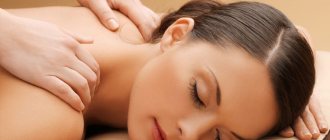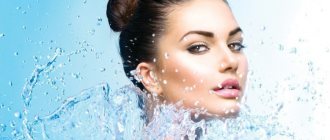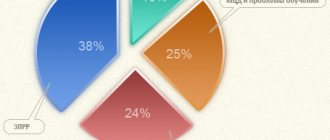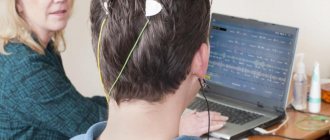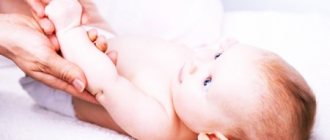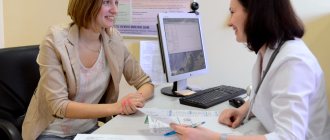Home » Useful » 7 types of reflexology - what it is and what it treats, cost and reviews
Author of the article
Agata Kozhukhova
Reading time: 9 minutes
AA
Modern medical methods involve the use of different means . Along with herbal medicine, reflexology, which originated in ancient China . How effective is the reflexology method?
Reflexology concept
This is a set of measures aimed at influencing the use of body points. By clicking on the desired point, the functionality of the diseased organ is restored. By influencing biologically active points, organs are stimulated with impulses . The impulses transmit a signal to the brain, after which the functioning processes in the affected organ are launched.
The organism, the human body, is a single biological system. If one of the functions is disrupted, the entire system suffers . During the research, points were found that, when acted upon, can quickly bring the body back to normal.
Distinctive properties of points:
- have increased sensitivity when exposed to pressure or electric current;
- the process of oxygen absorption increases;
- the process of micro-circulation of blood and lymph becomes active .
Despite the fact that the method is unconventional, it is recognized by official medicine. Acupuncture, the use of metal balls, warm stones, and laser beams are widely used.
Note! Reflexology can be prescribed as an independent method of therapy, or in combination with prescribed medications.
Reasons to visit a reflexologist
The peculiarity of the techniques used by this doctor is that they affect the entire body, so the indications for his consultation are very extensive.
- The rehabilitation period after injuries and surgical interventions.
- Frequently recurring infectious diseases.
- Painful manifestations of premenstrual syndrome and menopause.
- Muscle spasms.
- Malfunctions of the digestive system.
- Headache.
- The presence of chronic pathologies of various organs and systems.
- Functional autonomic disorders.
- Feeling of chronic fatigue, disturbances in the psycho-emotional sphere, insomnia, increased anxiety.
to contents ^
History of appearance
There is no exact data on the time of occurrence. The origins of acupuncture go back to antiquity . Back then, needles were used as healing methods. To get rid of pain, a person instinctively tries to press on the point . Thus, points that could be influenced gradually began to be identified.
Archaeological excavations indicate that stone, bone and bamboo needles were used in ancient times.
The birthplace of reflexology is China . In Europe, the method began to be used only in the 17th century. On the territory of the USSR, acupuncture was recognized in 1957 during the exchange of experience with Chinese doctors. Acupuncture originated in Tibet. Then it began to be used in Nepal and India. From Japan and China, the method quickly spread to the countries of the East - Mongolia, Korea.
A new stage in the development of the technique began in 1949. They began to study the technique in more depth and develop a scientific basis for the actions of doctors.
Now there are a huge number of monographs on the topic, even two research institutes have been created - the “Institute of Pain Control”, the second in Tokyo.
The method came to Europe in the 17th century , and was spread by missionaries. In 1978, a unified reflexology program was created for advanced training institutes for doctors. In the 90s, acupuncture experienced a heyday, and since 1998, the specialty of a reflexologist has been included in the register of medical specialties.
Theories of the mechanism of action of reflexology
Currently, there are many theories about the principles of reflexology on the body. The most popular theories are:
- Capillary theory. According to this theory, acupressure treatment helps relieve pain syndromes and qualitatively improves metabolic processes.
- Tissue theory. The idea is that reflexology activates the biological processes of the body.
- Histamine theory. It is based on the fact that under the influence of active histamine, metabolic processes are stimulated, and the body begins to strengthen its resistance to disease.
There are also many other theories (ionic, flocculation, electrical) that are based on physical effects for medicinal purposes on the human nervous system, through which a coordinating and trophic effect occurs on damaged areas and impaired functions. This fact determines the versatility, versatility and breadth of use of reflex therapy in the treatment of a wide variety of diseases.
Types of reflexology
When using different methods of reflexology, you can slow down or speed up the movement of energy that is in the affected organ. When choosing a method, pay attention to which organ is damaged and how deep the damage is.
Types of reflexology:
| Types of treatment | Description |
| acupuncture | An effective technique that directly depends on the angle at which the needle is inserted. Has a calming, tonic effect. Small needles can be left in the skin for several days |
| auriculotherapy | Acupressure of active points of the auricle. There are more than 250 points on the sink. Normally, they are painless; pressing on the points may cause pain. If there is a chronic disease, then diaper rash and pain appear at the active point. |
| acupressure | Mechanical impact on the points using a finger or special medical instruments. The integrity of the skin is not compromised. |
| thermopuncture | Use of heat. Wormwood cigars are used for this purpose. |
| electropuncture | Application of electric current |
| microcurrent | Used as an independent method. Often used to treat children with cerebral palsy. |
| magnetopuncture | Exposure to magnetic field. Relieves pain in chronic diseases |
Note! The method is prescribed by a specialist after studying the patient’s medical record. The patient cannot independently choose the direction of treatment.
What is reflexology? Interview with a specialist
Drug treatments for neurological diseases do not always bring the desired effect. Then it is worth turning to other types of therapy. Daria Aleksandrovna Maslova is a neurologist and reflexologist at the Consultative and Diagnostic Center of the National Medical Research Center of Oncology named after. N.N. Petrova spoke about an alternative to pills.
— Daria Alexandrovna, tell us what reflexology is?
— Acupuncture (acupuncture, acupuncture) is one of the few treatment methods that appeared in ancient times in the east and is used almost unchanged today throughout the world. The basis of the method is the impact on biologically active points, which are located literally throughout the human body. According to some data there are about 360 of them, according to others more than 800. Biologically active points are areas of the greatest activity of the interaction system “integument of the body - nervous system - internal organs” projected onto the skin. If they are exposed to an impact precisely calculated in strength and duration, then recovery mechanisms can be activated.
— How exactly does a reflexologist influence biologically active points?
— There are many methods. For example, electropuncture - exposure to a weak electric current, apitherapy - bee venom; acupressure - direct pressure on biological points; hirudotherapy - exposure using leeches; pharmacopuncture - administration of medications to acupuncture points. This list can be continued, but still, the most popular method is acupuncture. Since this is the method I use, I will talk about it in more detail. After getting to know the patient, the results of examinations, the doctor determines the treatment tactics, the number and duration of procedures. During an acupuncture session, the doctor places needles at biologically active points according to certain patterns and to a certain depth - from several millimeters to several centimeters. Usually from 2 to 15 points are involved. During the course, the desired therapeutic effect is achieved. At the same time, the patient has a minimal risk of complications or allergic reactions, because For procedures, thin disposable needles made of medical alloys are used.
— Who should not undergo acupuncture?
— Exhausted patients, as well as patients with inflammatory or infectious diseases, accompanied by an increase in temperature and changes in blood counts, people with diseases of the respiratory and circulatory system, liver and kidneys during an exacerbation. A state of any kind of intoxication, acute mental agitation, pregnancy, active form of tuberculosis will also be a contraindication for the procedures.
— In your opinion, what other advantages of acupuncture?
“This is an effective non-drug treatment method that can be used either in combination with other types of treatment or independently. Acupuncture is becoming a solution for those who cannot take medications or undergo other types of treatment. In some cases, acupuncture allows you to reduce the number of medications taken, reduce their dosage, and also avoid additional prescriptions of medications. In addition, acupuncture gives a delayed effect, i.e. The patient's condition gradually improves even after the course of treatment.
— For what diseases is acupuncture prescribed?
— The range of indications is very wide. Neurological manifestations of spinal osteochondrosis in the form of pain and muscular-tonic syndromes, migraine and other types of headaches, trigeminal neuralgia, facial nerve paresis, autonomic-vascular dystonia, consequences of injuries to the brain, spinal cord, peripheral nerves, allergic diseases (neurodermatitis, vasomotor rhinitis ), diseases of the respiratory system (protracted chronic bronchitis), diseases of the digestive system (peptic ulcer of the stomach and duodenum, chronic gastric dyskinesia, chronic gastritis) and many other diseases, as well as treatment of pain in cancer patients. Acupuncture for benign and malignant tumors can be performed according to indications for the treatment of other nosological forms of the disease and in the presence of pain as a method of analgesic action.
— How many reflexology sessions may a patient need?
— The course is always determined individually. On average from 7 to 15 times. The duration of the courses can also be different - from 15 to 40 minutes.
— How is the acupuncture procedure performed?
— The patient is in a comfortable environment, in the most comfortable position, which allows him to relax. The most suitable position is the horizontal position, but depending on the location of the points to be affected, other positions are also chosen. After a conversation with the patient, the doctor begins manipulation according to a pre-designated algorithm. After some time, the needle is removed. During the procedure, the patient is relaxed and can fall into a short sleep.
— Is acupuncture painful?
— Correct and technically correct needle insertion is almost not accompanied by pain, but the sensations largely depend on the patient’s mood and his ability to relax during the procedure. Also in reflexology there is the concept of intended sensations or the “needle phenomenon”, i.e. As the needle moves deeper into the tissue, short-term sensations of numbness, tingling, heaviness, aching, or the passage of electric current may occur. The variability of sensations is determined by the types of receptors and vegetative formations in this zone. In addition to the intended sensations, there is also a local skin reaction, most often redness or pallor of the tissue around the needle. After a personal conversation with the patient, most fears are dispelled, but you can always choose the most suitable technique, for example, vacuum therapy or warming up biologically active points.
Indications and contraindications for use
Despite all the positive aspects, there are a number of contraindications that are worth paying attention to. It is prohibited to use:
- oncological diseases, benign tumors;
- mental instability;
- pregnancy;
- infectious and inflammatory diseases;
- tuberculosis , its open form.
Note!
The main contraindication is intolerance to substances that are administered when using the techniques. The doctor makes appointments taking into account medical procedures that may put the body at risk. It is prohibited to use the technique if a strip operation was performed.
Among the positive effects are:
- relieving pain;
- restore joint mobility;
- normalize sleep;
- restore metabolic processes;
- stabilize the state of the vegetative-vascular system.
Many patients experience positive dynamics only if complex treatment is prescribed.
See photo gallery:
How does the reflexology procedure work?
According to the Eastern theory of disease, the skin, nerve bundles and internal organs interact. Reflexology reduces the effects of stress and helps the body recover and regulate the imbalance itself.
After the diagnosis, the doctor determines the areas that require stimulation. Then he inserts sterile thin needles into the points. As a rule, it is painless.
After inserting the needles, the patient lies in a relaxed state for 15-20 minutes (course of treatment is 8 procedures). Sensitivity may increase by the third or fourth session. This is a positive point, which indicates an improvement in the passage of nerve impulses and energy meridians.
Negative consequences
Before making appointments, you should find out the patient’s tendency to allergic reactions and check their health status .
Common negative effects are:
- the appearance of a headache ;
- the appearance of pallor on the skin;
- the appearance of tingling in the area where needles were previously installed;
- nausea;
- weakness;
- the appearance of hematomas after the manipulations.
Reflexotherapy treats diseases of varying severity , providing a prolonged effect. It is used after chemotherapy and can be used in patients of any age.
You can undergo reflexology treatment programs at the sanatoriums of the Ministry of Defense:
- Sanatorium "Divnomorskoe"
- Sanatorium "Solnechnogorsk"
- Sanatorium "Slobodka"
- Sanatorium "Cote d'Azur"
- Sanatorium "Gold Coast"
- Sanatorium "Borovoye"
- Sanatorium "Molokovsky"
Results and discussion
When analyzing the data obtained, it was revealed that in the 2nd group of patients, in which only drug treatment and psychotherapy were used, 1 month after observation there was a decrease in the number of children with tics by 30.8%, with hyperactivity, fatigue and attention deficit - by 23.1%. The number of subjects with headaches and memory loss did not change.
In the 1st group of patients, where complex treatment was used, 1 month after observation, the number of children with tics and hyperactivity decreased by 58.8%, with fatigue - by 53.0%, with attention deficit - by 64.7%, with headaches - by 40.9%, with memory loss - by 52.9%.
When comparing the data obtained in groups 1 and 2, it was noted that the number of children with tics, attention deficit and hyperactivity decreased almost 2 times, more in group 1 than in group 2 ( p
<0.05), with headaches and memory loss - only in group 1. The data obtained indicate the effectiveness of complex treatment using reflexology.
After 4 months of observation in the 2nd group, there was a decrease in the number of children with tics and attention deficit by 46.2%, with hyperactivity by 38%, with fatigue by 30.8%, with memory loss by 23.1%, with headaches. pain by 15.3%.
In the 1st group of patients, after 4 months of observation, there was a decrease in the number of children with tics by 88.2%, with hyperactivity - by 82.3%, with memory loss - by 76.5%. Headaches, attention deficit and fatigue were not recorded in children of group 1 after 4 months of observation.
When comparing the data obtained in groups 1 and 2, it was noted that after 4 months of observation, the number of children with tics and hyperactivity decreased by 2 times, more in group 1 than in group 2 ( p
<0.05). Headaches, attention deficit and fatigue completely disappeared only in patients of group 2. The data obtained indicate the effectiveness of complex treatment using 3 courses of reflexology.
Cost of the procedure
The cost depends on which method was prescribed to the patient.
- acupuncture - 950-2000 rubles. At least 10 sessions are required ;
- use of an electrical impulse - 2000 rubles. ;
- acupuncture for weight loss 500 -2000 rub. ;
- for infertility - 1300 - 2100 rubles. ;
- from smoking - 1000 rubles.
Note! The price is indicated for one visit. Minimum quantity of 5 or more.t
Features of microneedling
Microneedles are inserted into both corporal acupuncture points (on the limbs and body) and auricular points. The length of their rod is 2-3 mm, the diameter is up to 0.2 mm. In appearance, therapy needles resemble tiny push pins. For proper placement and convenient fastening on the skin, they are equipped with holders in the form of wire coils. Microneedles for auricular therapy are made of stainless medical steel, silver or gold, hypoallergenic metal alloys.
An important component of acupuncture is the occurrence of local non-infectious inflammation in the area where the microneedle is installed. This inflammation also has pronounced healing properties - it enhances nutrition and blood circulation of the areas that are subjected to acupuncture and the organs connected to these areas through nerve endings.
Indications for microneedling may include:
- diseases of the nervous system;
- pain syndromes in the ear and other locations;
- withdrawal syndrome (occurring in the process of quitting smoking and alcohol abuse);
- allergic conditions;
- metabolic disorders;
- inflammatory and degenerative-dystrophic pathologies of the musculoskeletal system, etc.
Benefits of treatment
The benefits are obvious. It can be prescribed both for ordinary ailments and for serious diseases - back, migraine, premenstrual syndrome.
It also helps determine the presence of an impending disease. Once the danger is determined, the required number of sessions is prescribed.
If treatment is carried out regularly, the patient can maintain his health.
Note! The techniques can be used at home, but only to achieve a relaxing effect.
Relative readings
- Thyrotoxicosis with or without goiter.
- Diabetes.
- Obesity.
- Hypothalamic syndromes without pronounced neuroendocrine and metabolic disorders.
- Gout.
- Encephalitis, myelitis, encephalomyelitis, consequences of acute polio.
- Progressive muscular dystonia.
- Shaking palsy (Parkinson's disease).
- Multiple sclerosis.
- Cerebral palsy.
- Epilepsy.
- Syringomyelia.
- Peripheral retinal degenerations, focal retinochoroiditis, acute and subacute iridocyclitis, vascular disorders of the iris and ciliary body.
- Glaucoma (initial form, pain syndrome).
- Otosclerosis.
- Paroxysmal tachycardia, unspecified.
- Transient cerebral ischemia, long-term consequences of cerebrovascular disease (with moderate dysfunction).
- Pain syndromes in diseases of the gallbladder and biliary tract.
- Chronic pancreatitis.
- Pain syndromes in organic diseases of the genitourinary organs.
Preventing presbyopia
It is impossible to protect yourself from the development of presbyopia: it is a natural process that sooner or later overtakes every person. However, you can delay the loss of elasticity of the lens and stop the progressive decline in visual acuity if you follow the following recommendations:
- do eye exercises at least once a day;
- adhere to a balanced diet containing fruits, vegetables, fish, meat, dairy products, grains;
- take medications with vitamins B, A, C, magnesium, zinc, chromium as prescribed by your doctor;
- avoid excessive visual strain, take regular breaks when working at the computer, reading, writing;
- follow recommendations regarding the correct position at the table and lighting of the workplace;
- Visit an ophthalmologist regularly for timely vision correction.
The Lensmaster network invites you to have your vision tested at one of its salons located in Moscow, St. Petersburg and 12 other cities in Russia. Our ophthalmologists will conduct diagnostics, select the optimal correction products and offer to purchase them at competitive prices.
Why do patients come to the Moscow clinic?
All doctors of the Moscow clinic who work in this area provide high-quality treatment services and have a special specialized education as a reflexologist , which is confirmed by an appropriate valid certificate. The specialists also have knowledge in the field of neurology, therapy, topographic anatomy and psychotherapy. Depending on the category and complexity of the disease, the attending physician chooses the most suitable method for each patient. At the first appointment, the specialist carefully examines the symptoms and collects a detailed history to determine the patient’s general condition, based on which he determines the true cause of the problem, and then prescribes appropriate effective treatment.
In the Moscow Clinic , located near the Maryina Roshcha metro station and the Savelovskaya metro station (SVAO) in Moscow, the reflexology department is represented by highly qualified doctors and extensive clinical experience. After visiting our clinic, you will definitely recommend it to your relatives, friends and acquaintances!
Registration of patients in our clinic is carried out online on the clinic’s website or by calling +7 (495) 106-49-77. This is very convenient, since you know in advance which specialist you are going to see and can choose a convenient time for yourself.

